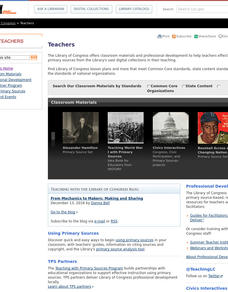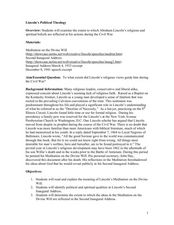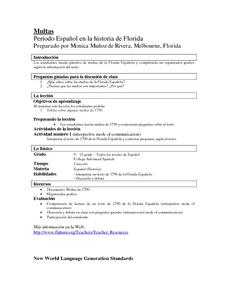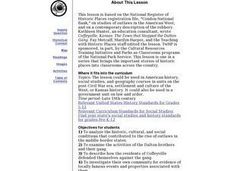Curated OER
Cinco de Mayo
Students investigate the Cinco de Mayo holiday. They discuss the history of Cinco de Mayo, listen to the Legend of the Mexican flag, color a worksheet of the Mexican flag, and create a class coat of arms.
Curated OER
From Slave to Entrepreneur: The Life and Times of William Ellison
Eighth graders interpret historical evidence presented in primary and secondary resources. In this South Carolina history lesson, 8th graders examine sources that require them to examine the life of William Ellison, a black slave owner.
State Bar of Texas
Brown v. Board of Education
You walk each day over 20 blocks to school as a 9-year old because the color of your skin does not allow you to attend a school in your own neighborhood. Scholars use the 1954 Supreme Court case Brown v. Board of Education to investigate...
Curated OER
Dos mapas de Florida, el Caribe y parte de Sur America
What can maps tell us about the past? Find out with a Spanish lesson that incorporates geography. After examining maps individually, comparing two old maps of Spanish Florida and writing notes in the provided Venn diagram, pupils pair up...
Curated OER
A Question, Mr. Lincoln!
Students discuss Abraham Lincoln. In this social science lesson, students describe key events in Lincoln's life. Students practice using interviewing skills to gather information pretending to be Lincoln.
Curated OER
The Greatest Educational Change America has Ever Seen
Students examine the history of the penny. In this Lincoln Bicentennial One Cent teachers guide, students connect the life of President Abraham Lincoln to the 1-cent coin in his honor through a variety of lessons and activities.
Roy Rosenzweig Center for History and New Media
The Homestead Act
To understand how the Homestead Act of 1862 changed the US and the lives of the people during that time, class members examine primary source materials including letters, broadsides, and images. They then assume the voice of a...
State Bar of Texas
Plessy v. Ferguson
Where did separate but equal originate and what does it mean? Scholars investigate the Supreme Court Case Plessy v. Ferguson. Using a short video clip, they analyze the impact the decision of legal segregation had on society in 1896....
State Bar of Texas
Sweatt v. Painter
Is separate but equal actually equal? The 1950 Supreme Court case Sweatt v. Painter discusses the law of segregation and inequality. Scholars investigate the impact of the case on the desegregation of public schools across the nation...
Curated OER
The True Cost of Coffee
Students examine the economic, health and environmental risks of being a one-crop country. They explain the risks of relying on one crop. They also identify the factors that resist change.
Curated OER
With Malice toward None: Lincoln's Assassination
Students analyze primary documents regarding Lincoln's assassination. In this activity on Lincoln's assassination, students analyze three primary sources of information regarding President Lincoln's assassination.
San Francisco Symphony
Adding Music to Oklahoma History
To better understand Oklahoma state history, learners will use a website to find a song that supports or represents aspects of Oklahoma's history. They'll write three sentences defending their choice, and then they will create...
Center for History and New Media
The Daily Experience of the Laurel Grove School, 1925
What was daily life like for those attending segregated schools in 1925? Modern learners fill out a KWHL chart as they explore historical background and primary source documents about the Laurel Grove School in Fairfax County, Virginia....
Federal Judicial Center
Amistad and Dred Scott—a Comparative Activity
What do slaves fighting for their freedom on board a ship and a slave fighting for his freedom in a courtroom have in common? Budding historians investigate the two different cases of the Amistad slave revolt and the Dred Scott argument....
Curated OER
Louisa May Alcott: The Candle and the Mirror
Students discuss the life of Louisa May Alcott and create an outline of a biography of her life and times. In this Louisa May Alcott lesson, students explore the Transcendentalist involvement in the abolitionist movement, relating...
Smithsonian Institution
Watching Crystals Grow
Amazing science can sometimes happen right before your eyes! The class gets cozy as they watch crystals grow. They use Epsom salts, rocks, and food coloring to create crystals. They'll observe the entire process, documenting every step...
Curated OER
The New Deal: North Carolina's Reconstruction
Eighth graders study North Carolina's reconstruction through an interdisciplinary project that emcompasses social studies, language arts, visual art, music, and technology.
Curated OER
Race and Representation
Students consider race and representation. In this voting rights lesson, students listen to their instructor lecture on the Voting Rights Act of 1965, Georgia congressional districts, and North Carolina voting districts. Students respond...
Curated OER
Lincoln’s Political Theology
Young scholars consider the weight of Lincoln's spiritual life on his political life. For this Abraham Lincoln lesson, students read excerpts from speeches delivered by Lincoln and determine whether they reveal information about...
Eastconn
Learning to Analyze Political Cartoons with Lincoln as a Case Study
Discover the five main elements political cartoonists use—symbolism, captioning and labels, analogy, irony, and exaggeration—to convey their point of view.
Curated OER
Images of Secession
Analyze political cartoons and historical events. Middle schoolers utilize primary resources to increase their comprehension of the topic of secession. They utilize graphic organizers to take notes, compare, and analyze political...
Curated OER
Multas
Combine history and Spanish instruction with an exploration of descriptions of fines given in Florida in 1790. Partners read the brief text, fill out a graphic organizer about the crimes described, and interview each other about fines....
Curated OER
Jazz in America
Students learn where Jazz came from and why it is an important part of America's history.
Curated OER
Condon National Bank
Use maps, readings, and photographs to analyze the historic, cultural, and social conditions surrounding the activities of the Dalton brothers and their gang. Learners identify how the residents of Coffeyville defended themselves against...

























